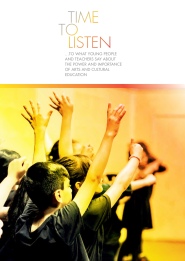
Time to Listen reports what students say about the value of arts and cultural education. The TALE project gathered 6000 responses from young people aged 14-18 in secondary and special schools around England.
Download the Time To Listen Summary Report (PDF) here:

One clear and consistent message comes from students: arts and cultural learning taps into their imagination, creative instincts and self-worth in ways that other lessons do not.
Find out more. Download the final report of the project (PDF).
Time to Listen – TALE Project Final Report
The findings from the Tracking Arts Engagement and Learning Survey show the ways in which arts and cultural learning in the classroom opens doors to creative activities outside school hours. More than a third of the students said school is the only opportunity they have to engage in arts activities. Students in TALE schools are more culturally engaged out of school than the national average, showing that school is a crucial for ensuring the entitlement of young people to arts and cultural education.
Read the TALE school survey results in full. Download the PDF here: Overall_School_Report_16_05_2018
Watch Pat talk about the major findings from the research – a keynote at the Thriving Child conference, held by the Royal Opera House youth arts team in July, 2019.
Watch the launch of the Time to listen report at Westminster.
Publications
Arts teachers are different (and why this matters)
This short paper for the Chartered College of Teachers journal Impact reports that students overwhelmingly told us that their arts teachers were like other teachers. This paper explains why, looking at the way in which arts teachers broker wider participation and engagement with the arts.
Download the author copy as PDF Whats different about arts teachers
Arts education and the right to culture
We see arts education as a vital part of a young person’s broader cultural education. We think arts education is fundamentally about learning to produce and represent meanings, so good arts education involves doing (e.g. making or interpreting) and being (e.g. taking on the role of artist or performer) as well as knowing. We explain our position in this book chapter.
- Download author copy PDF: TALE the right to culture
Beyond civics: Art and Design education and the making of active/activist citizens
We argue in this chapter that while Civics might be the responsibility of a particular subject teacher, all teachers and the whole school teach students about democratic life. if the school is a polis then teachers can work with active citizenship pedagogies, and teach material that raises questions about democratic practice and issues of concern in democratic societies. We discuss what this means for Art and Design in particular.
- Download author copy PDF: cultural citizenship in Art and Design education
Arts subjects choice as resistance and accommodation
Our research showed that young people often chose arts subjects even if they did not intend to go on to further arts study or to a job in the arts. They told us that they saw the arts as something that they would do all of their lives. But they also said that the arts were very different from their other subjects and this was very important to them. In this paper we explore the importance of the everyday experience of arts education.
- Download author copy PDF: Why study the arts? FINAL AUTHOR COPY
The pedagogical logics of arts rich schools: A Bourdieusian analysis
One of our key findings was about the importance of teachers who brokered young people’s access to and experiences of a wide range of arts events and organisations. Arts broker teachers were often practising artists themselves and were always engaged audiences. They embodied what it means to live as active cultural producers and consumers and made it possible for their students to choose to do the same. They were supported in this work by their schools. This paper offers a theoretical explanation for why and how this was possible.
- Download author copy PDF arts broker TALE final author copy
More information is available on our Additional Resources and Publications page.